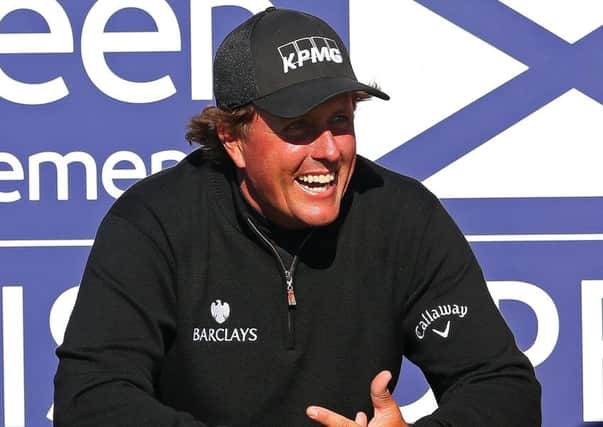Mike Aitken: Mickelson a Scots crowd favourite


DURING one of Phil Mickelson’s first visits to the Scottish Open, when the event was staged at Loch Lomond, the southpaw golfer only arrived on the bonnie banks the day before the tournament began and managed but a cursory warm-up to Scotland’s national championship.
Although he passed on coming to the media tent to conduct a formal interview before play began the next day, the one aspect of the multiple major winner’s obligation to the event which wasn’t curtailed that week was his consideration for the young autograph seekers who gathered in their hordes behind Rossdhu House to meet the golfing icon.
Advertisement
Hide AdAdvertisement
Hide AdMickelson didn’t just sign for some of the boys and girls who wanted a memento that afternoon, he did it for all of them, patiently working his way along the deep line and gifting his time to a group of young Scots who, years later, when he lifted the Claret Jug at Muirfield, surely cheered his momentous victory in the Open as loudly as any of the American’s compatriots.
As with much of his career, Mickelson’s inspiration for giving back to the game came from the example set by Arnold Palmer. At the US Open in 1994, he saw Palmer spend an hour of his time signing autographs and thanking a group of volunteers for their contribution. “I just thought it was a classy thing to do,” he recalled.
Since Bobby Jones cemented his place in the hearts of so many Scots by declaring that he could take everything out of his life except his experiences in St Andrews and still have led a rich, full life, only a handful of American champions have been similarly embraced at the home of golf.
Jack Nicklaus’ relationship with Scotland was so special that he even found his image immortalised on a £5 note. Palmer single-handedly resurrected interest from America in the Open from the moment he teed up at St Andrews in 1960 and Tom Watson experienced an epiphany on the links at Royal Dornoch in 1981 when, the year after winning the third of his five Opens at Muirfield, he joyfully declared never having more fun anywhere on the planet playing golf.
While Mickelson’s storied career may not quite carry the lustre of those legends of the game, his popularity in Scotland is almost as intense and indisputably surpasses the standing here of any of his contemporaries.
This is not so much because of his five successes in the majors, including that triumph at the home of the Honourable Company of Edinburgh Golfers where he was four under par for the closing six holes, though those victories surely confirmed his status as a swashbuckling champion in the tradition of Palmer and Seve Ballesteros.
Affection from Scottish galleries is hard won and derives from what the player puts in as much as how he’s rewarded. In that respect, Mickelson’s role can’t be underestimated in establishing the Scottish Open as the leading event on the European Tour after the flagship BMW PGA Championship at Wentworth. Just as Palmer led America’s pre-eminent golfers back to the Open in the 1960s, so has Mickelson’s support for the Scottish Open in the 21st century encouraged leading US players of the calibre of Rickie Fowler, ninth in the world rankings at the time of writing, Jimmy Walker, 11th, Matt Kuchar, 18th, Brooks Koepka, 22nd, Ben Martin, 54th, Cameron Tringale, 66th, and David Duval, the former Open champion, to tee up this month at Gullane.
The first staging of the championship in East Lothian will mark Mickelson’s 12th Scottish Open appearance since 2000 and his sixth consecutive place in the line-up. Where once he made the annual pilgrimage to get over jet lag and stir his competitive juices – on home turf he also chooses to play in the PGA Tour events which precede the Masters, the US Open and the US PGA – the move away from Loch Lomond in 2011 as the permanent venue (where it had flourished since 1996) to a rotating circuit of seaside links turned the Scottish Open for Mickelson into the perfect preparation for the Open.
Advertisement
Hide AdAdvertisement
Hide AdDuring three visits to Castle Stuart before savouring the more traditional test of Royal Aberdeen in 2014 and a composite course at Gullane this summer consisting of 16 holes from Gullane No 1 and two from Gullane No 2, the profile of the Scottish Open has been raised high enough to ensure the presence of world No 1, Rory McIlroy.
Like many of his peers, McIlroy watched Mickelson win the Scottish Open in 2013 before hoisting the Claret Jug at Muirfield the following Sunday. It was a pattern which the Irishman all but emulated in 2014 when his 14th-place finish at Royal Aberdeen proved the launching pad for victory in the Open at Hoylake.
Mickelson’s success in 2013, as the American’s coach, Butch Harmon, confided, was a critical step for Phil on the journey from links student to Open champion. “I don’t think people realised how important winning the Scottish Open at Castle Stuart was,” said Harmon. “It isn’t as difficult a course as Muirfield but the environment is the same. You have to control your ball, watch how it bounces and control every other part of your game. That was a special win going to the Open.”
For a player who grew up thousands of miles from East Lothian in California and took decades to master the shots required to thrive on the British linksland, Mickelson’s victory at Muirfield was the ultimate vindication of his support over the years for the Scottish Open.